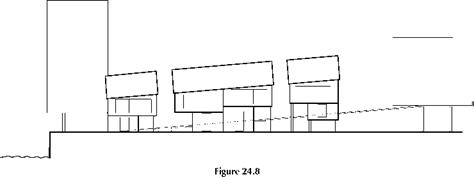Benefits occur no matter what the scale of intervention. Modest linear fields (Figure 24.1), can provide space for paths, which connect private and public spaces. Making their adjacency visible encourages movement between the two. The paths and connecting landscape can be thought of as interventions
Figure 24.5 Newark CPUL: Houses, paths and fields.
Figure 24.6 Newark CPUL: Houses look out over fields, towards a river beyond.
Figure 24.7 ElastiCity CPUL, Sheffield: Garden/courtyards mediate between the private realm of the house and the public realm of a CPUL. A two-storey core home can be enlarged by building single-storey additions in the garden/courtyard.

which mark and reveal. Routes to shops become adjacent to places where food is grown. Each walk amongst the crops heightens the experience of seasonality, and speeds up time because of the compact space within which nature is experienced. Time is intensified – more ‘nature’ for your time. No need to pack your bags to visit the countryside.
Figure 24.8 indicates improved access and interaction at its most elementary. Here houses are elevated above an urban agriculture field, their exact height determined by a requirement to provide access, for cultivators, to fields and to maximise solar access to the fields. At Newark ramps from the front door connect the houses to a river at one side and the city centre at the other. Vistas are created over the urban agriculture fields and the river, and houses float in a pastoral landscape.
Space promoting and provoking local interactions can be thought of as the space of encounters. (see Chapter 2). Imagine setting out into a continuous landscape, such as that proposed for Sheffield (see Figures 24.4 and 24.7). An individual will pass people engaged in different kinds of growing and cultivation. A pedestrian may come across farmers
using their land commercially, while also passing allotment holders engaged in activities that blend the social and productive. These encounters occur within the boundaries of a continuous productive urban landscape. But the site within which local interactions occur, extends beyond the boundary of individual fields or landscapes. By setting up connections, continuous landscapes expand their sphere of influence to include adjacent enterprises, recreational areas and institutions. The act of making and marking a connection promotes and engenders physical contact. In certain instances, fine bridges can span roads or rivers, breaking what are otherwise insurmountable barriers. Figure 24.9 demonstrates the strength of such a landscape bridge, proposed as a lightweight structure, providing spatial continuity across a road which, otherwise, destroys any sense of adjacency.



